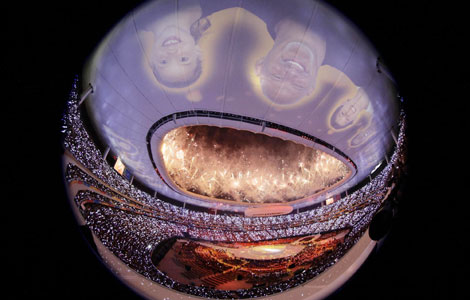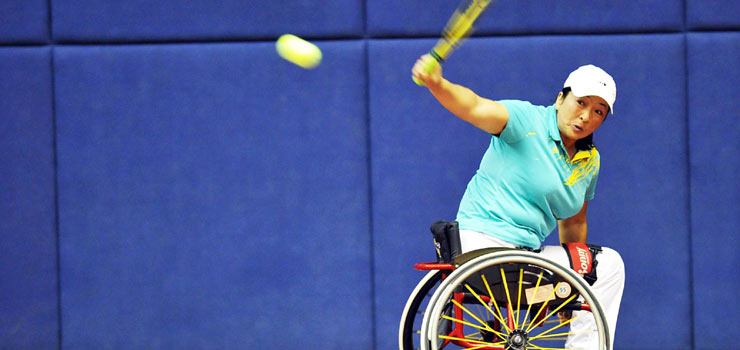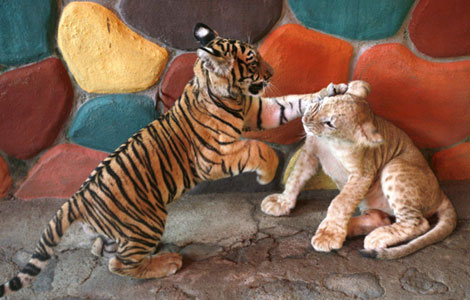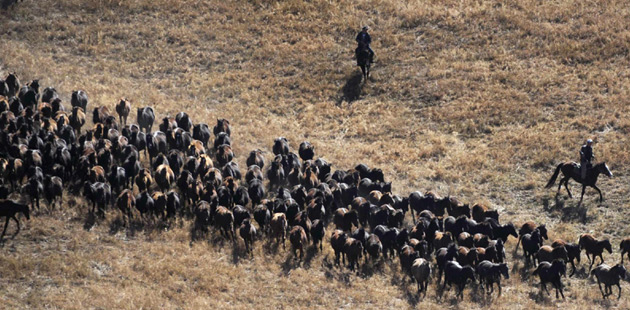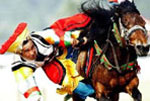From Cheongsam to Western Wedding Gown
Updated: 2011-10-16 09:41
(Xinhua)
|
|||||||||||
BEIJING - For just 200 yuan ($31), brides-to-be can score the Western-style wedding gown of their dreams at the Wedding Dress Mall in the western Beijing neighborhood of Wukesong.
This spacious mall is full of hustle, bustle, and 80 stores selling inexpensive wedding gowns that sparkle under bright lights.
Many brides-to-be wander in and out of shops, tailed by their husbands-to-be, mothers or friends. They try on many dresses in fan-shaped booths or impromptu dressing rooms created when a shopkeeper holds up swaths of fabric for girls to stand behind.
Once they decide which dress to buy, they bargain with the shopkeeper until a deal is struck. Then the dress-often decked out in ruffles, sequins, feathers or all three-is tucked into a giant bag and taken home.
"I would like to wear a white fluffy dress. It will make me feel like an elegant princess, just like Kate Middleton, the wife of Prince William," said Linda Wang, a 27-year-old bride-to-be from Beijing's suburban Tongzhou District who settled on a dress with a price tag of 500 yuan.
Wang said the dresses here look just like big name-brand dresses, but are much more affordable. And, here, buying a dress is even cheaper than renting one, as rentals can run over 1,000 yuan.
"In other wedding dress shops in Xidan or SOHO in Beijing, the price of a wedding dress soars-from 5,000 yuan to more than 20,000 yuan," she said.
Wang does not care much about the texture or quality of the dress. "I will only wear it once, so it really isn't worth too much money. But the wedding dresses all look like the same, so it's really difficult to decide."
Wang is not the only Chinese bride hunting a Western-style wedding dress, as these styles have become common regalia for Chinese weddings today. Meanwhile, some bribes still prefer wearing a cheongsam or any kind of traditional Chinese wedding dress to be distinctive .
In the Ming (1368-1644) and Qing (1644-1911) Dynasties, a bride typically donned a phoenix coronet and an embroidered vest inspired by the royal costume of the Ming Dynasty.
The Revolution of 1911 ended feudalism and dynastic traditions in China, and led to the formation of the Republic of China. The cheongsam began China's sort of national costume for women during this time.
The cheongsam, or qipao in Mandarin Chinese, evolved from the female forms of Manchu fashions, which were originally made to be loose to hide a woman's figure. During the 1920s, tailored and fitted cheongsams gained quick popularity among Shanghai's upper-class women.
The Revolution aimed to end all feudal influences and traditions, including wedding ceremony. A new style of wedding ceremony known as a "civilized wedding" in Chinese was formed and promoted after the Revolution.
In the civilized wedding, traditional Chinese etiquettes were simplified and the ceremony was significantly shortened. The groom wore a black robe with a mandarin jacket worn over it, while the bride dressed in a cheongsam and bridal veil, and carried a bouquet of flowers.
Traditionally, a bride wore red, a color symbolizing joy and happiness, on her wedding day. White symbolizes death or a funeral and, therefore, was not a traditional gown color.
Western-style dresses first came into fashion in China after Chiang Kai-shek and Soong May-ling's wedding in December 1927. At the wedding, Soong wore a conventional western-style floor-length gown made of white satin and lace, and she carried a massive flower bouquet.
Western-style wedding gowns were considered a sign of bourgeois lifestyle during the Cultural Revolution (1966-76) and were thus forbidden in China. Weddings during this era had to be as austere as possible, and most couples wore ordinary clothes while some dressed as Red Guards, carrying Chairman Mao's quotations in lieu of a bouquet.
Western-style wedding gowns made a comeback in China in the 1980s after the country started the Reform and Opening Up Policy. Today, most brides wear a western-style gown before changing into a cheongsam when it's time to make the toast.
Although wedding ceremonies vary according to different traditions observed throughout China, a western-style dress is a must-have for almost every Chinese bride-even those in remote, rural villages.
Zhang Chengjun, a 24-year-old migrant worker from Lixian County in northwest China's Gansu Province, noted that many brides in his village would like to dress in white, but the color is still a taboo for older people, so many opt for a red gown instead.
"My wife personally prefers the white one, because it is popular and also looks pure," Zhang said.
Still, brides in more open-minded villages can wear whatever dress they like. Yang Lei, a 26-year-old security guard from a small village in Handan, Hebei Province, said his wife wore a white gown that she thought "would make her look like a princess."
"I don't really tell my wife what she should wear. She should just pick what she thinks is beautiful," he said.
"There has been a great shift in the mind of most Chinese people in accepting a bride wearing a white dress on her wedding day," said Yu Fan, who runs a wedding dress shop in downtown Beijing. "Today, almost every girl dreams of wearing a western wedding dress."
But, she said, the western-style gowns have been heavily altered to suit the stature and skin color of Chinese brides. Wedding dresses with clusters of sequins and embroidered peonies or phoenix are more popular than unadorned, simple dresses.
Wedding dress workshops in southern cities like Hangzhou, Suzhou and Shenzhen supply shops like Yu's in Beijing, but some brides opt to skip the shops by going straight to the dressmakers. Huqiu Wedding Dressing Street in the city of Suzhou in Jiangsu Province is famous for its cheap wedding dresses and attracts brides from far and wide looking for the dress of their dreams.
Tailors can copy designs from foreign brands and some design their own gowns. A tailor in Huqiu claims to have made the first copy of Kate Middleton's dress just 31 hours after the royal wedding.
But, to Yang Se, the founder and CEO of idoido.com.cn, a popular website offering wedding service information, a wedding dress is more than just a thing of beauty.
"The wedding dress is a holy and traditional symbol that represents solemnity of marriage. People should treat it with respect," Yang said.
Yang, 31, has guided hundreds of wedding ceremonies and is currently preparing for her own wedding. She plans to wear a Vera Wang gown for her wedding ceremony which will be held in Los Angeles.
Yang would like to pass her wedding dress down to her family's future generations, and "tell them what the dress really means to a bride."
"I have been anticipating my wedding day since my childhood. I got excited whenever I watch a wedding in films and TV," she said, adding that the character Monica's wedding scrapbook from the American TV show "Friends" inspires her desires to get married in a Western-style wedding gown.
Just like Yang, Linda Wang also wants a Western wedding ceremony. She has been to Wukesong six times already, but still has not made a decision of which dress to buy.
"My wedding should be romantic, held in the lawn and have many garlands and bouquets-just like what I have seen in movies," Wang said.
"And I will look more beautiful when I'm in a Western-style wedding dress."
Hot Topics
Libya conflict, Gaddafi, Oil spill, Palace Museum scandal, Inflation, Japan's new PM, Trapped miners, Mooncake tax, Weekly photos, Hurricane Irene
Editor's Picks
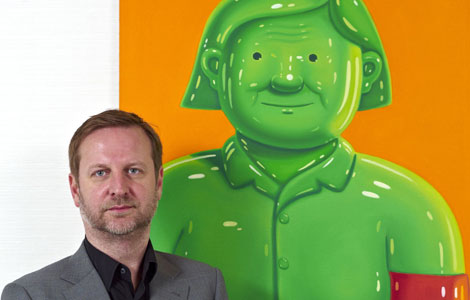
|
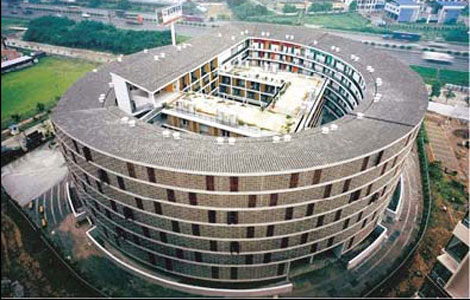
|
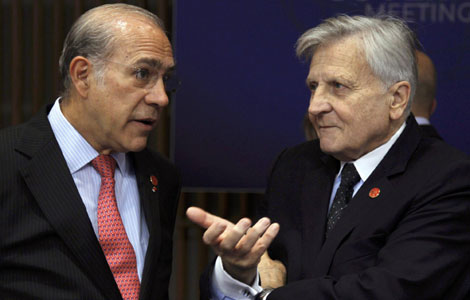
|

|

|
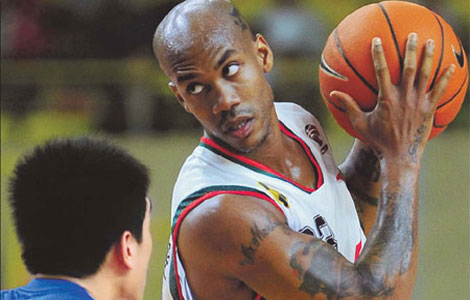
|


